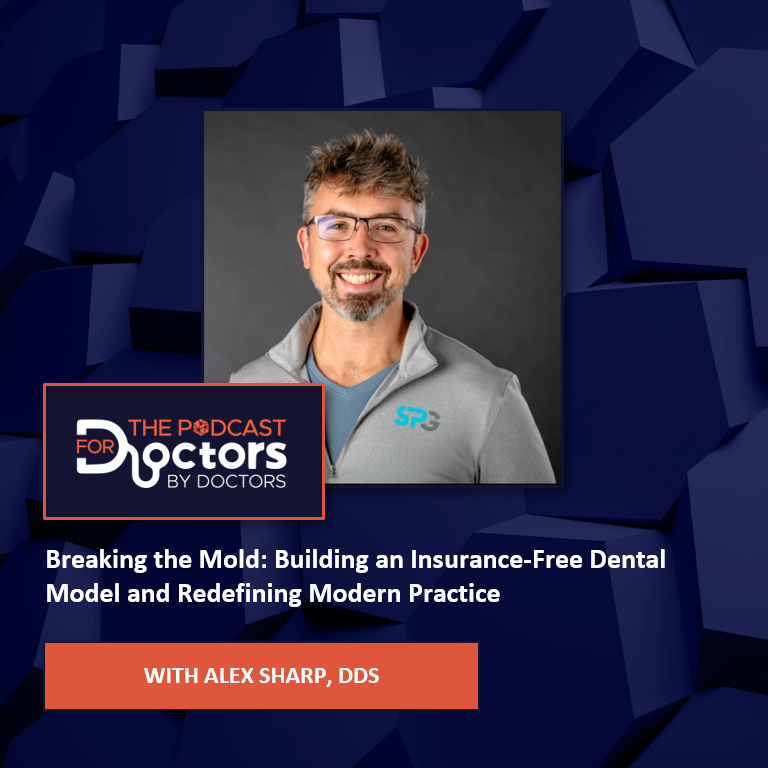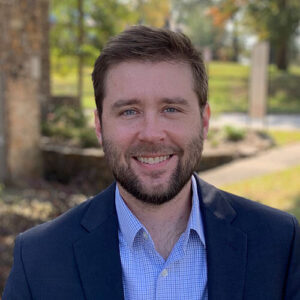Dentist, entrepreneur, and co-founder of Shared Practices Group, Dr. Alex Sharp joins Dr. Michael Jerkins to share how his unconventional career path—from high-volume associate to multi-practice owner and CEO—shaped his philosophy on patient care, business, and leadership.
He opens up about the lessons learned early in his career, the pivotal moment that pushed him toward practice ownership in Arkansas, and how those experiences inspired him to co-found Shared Practices Group, an organization focused on delivering full-arch implant care and achieving independence from insurance-driven dentistry.
Dr. Sharp reflects on the realities of running a practice through the COVID-19 pandemic, why differentiation is essential for any insurance-free model, and the balancing act between efficiency, accessibility, and patient advocacy. The conversation also explores how AI and automation are reshaping the field from radiograph analysis to scheduling and why maintaining a personal touch will always be essential in patient care.
What does it take to create a thriving, values-driven practice in an industry dominated by insurance and rising costs? And how can new dentists navigate student debt, business ownership, and a rapidly evolving technological landscape without losing sight of their “why”?
Dr. Sharp offers candid insights into the state of dental education, the future of dental specialties, and why adaptability and a healthy dose of skepticism toward “expert” advice might be the most valuable skills a dentist can have today.
Here are five takeaways from the conversation with Dr. Alex Sharp:
1. The Journey to Practice Ownership
Dr. Sharp discusses his transition from working in a high-volume office to owning his practice in Arkansas. This move allowed him to develop his entrepreneurial skills and implement his own philosophy of care. He emphasizes the importance of finding the right fit and the challenges of navigating the dental profession post-graduation.
2. Insurance Independence and Strategic Practice Management
Dr. Sharp highlights the feasibility and challenges of running an insurance-free practice. He stresses the need for differentiation and a clear value proposition to patients, as well as strategic management of procedures and volume.
3. Role of Technology and AI in Dentistry
The episode explores the role of technology and AI in dentistry, identifying opportunities for automation in areas like radiograph analysis and scheduling. Dr. Sharp cautions against over-automation that might alienate patients seeking personal touch.
4. Patient Advocacy and Viewing Dentistry as Essential
Dr. Sharp stresses the importance of patient advocacy, arguing that dentistry should be viewed as essential rather than elective. He advocates for a shift in focus towards patient outcomes and education to improve dental care accessibility and effectiveness.
5. Challenges and Opportunities in Dental Education
The discussion touches on the current state of dental education, noting the challenges new graduates face with student debt and the evolving landscape of practice ownership. Dr. Sharp emphasizes the need for dental schools to better prepare students for real-world challenges.
Transcript
Dr. Alex Sharp:
I think the challenge that business owners in dentistry—or in healthcare more broadly—have to care about is how to wear those different hats, or hire people to wear those hats for them, in a way that ensures they’re not caught off guard by something that could sink their business simply because it’s not their natural strength. That recognition, I think, is what often causes people to move into ownership later—if they do at all.
Dr. Michael Jerkins:
Welcome back to another episode of The Podcast for Doctors (By Doctors). I’m Dr. Michael Jerkins—not joined today by Dr. Ned Palmer. We’ve been switching off hosting duties recently, but we’re joined by a special guest: a fellow doctor who identified a business need, built a solution for it, and found success while helping patients.
I’m really excited to hear from another doctor who’s branched out beyond clinical work and found both satisfaction and success in business ownership. We’ll cover a lot today—not just what it’s like to be a doctor, but what it’s like to be both a doctor and a business owner. We’ll also get his thoughts on the current state of medicine and dentistry.
Without further ado, we’re joined today by the one and only Dr. Alex Sharp. Dr. Sharp is the co-founder and CEO of Shared Practices Group, a platform that empowers dentists to maximize their impact through life-changing full-arch care. Dr. Sharp, welcome to the podcast.
AS:
Michael, thank you for having me. It’s rare to meet someone as passionate about podcasting as I am—especially someone from a similar part of the country. It feels like serendipity that our paths crossed, and I’m thankful to be here.
MJ:
That’s very kind of you. I think this may be the only time in human history that two doctor-podcasters from the state of Arkansas have done a show together.
AS:
What do you think? It’s like in Ghostbusters—they say don’t cross the streams. I guess we’re doing that right now.
MJ:
We’re crossing the streams! Your bio is short compared to most I get, which are usually long and detailed. I think you’re underselling yourself a bit. Can you walk our audience through your journey from dental school to becoming the CEO of a national group?
AS:
Sure. The journey’s been interesting. I actually had a conversation earlier today with a team member and asked, “What does success in five years look like for you within our organization?” He said, “Five years is a long time.” And it made me think—if you’d asked me that question five years ago, my answer would’ve been very different from how things actually turned out.
I’m thankful for the way things evolved, but it’s hard to predict where you’ll end up. After graduating dental school, I got a job and thought, “Mission accomplished. I’ve graduated, got my license, and I’m working in a busy practice. I’ll be able to serve people, make a good living, and grow my skills.”
But coming out of dental school—just like medical school—you quickly realize no two jobs are the same. Each has its own mix of strengths and drawbacks. You have to jump into the deep end and figure out where you fit in this profession you’ve trained so long to join.
Eventually, I realized I was working in a high-volume office and only skimming the surface of the impact I wanted to make for my patients. So I bought my own practice in central Arkansas. That gave me the freedom to flex my entrepreneurial muscle—develop systems and practice the philosophy I believed in.
From there, I got into coaching, podcasting, and eventually merged with my business partners to form Shared Practices. We created it to serve dentists at a higher level—to help them elevate their understanding of what’s possible through better practice management so their time and energy go further.
Then COVID hit—and that threw everyone a curveball. I still remember giving my team binders that said “2020 Vision.” That was our theme for the year—having a crystal-clear vision of what we’d achieve together. And then… curveball.
That’s when I realized dentistry, broadly speaking, hasn’t met the needs of its professionals. Many dentists felt beholden to insurance companies to meet patient expectations—if the insurer said “jump,” dentists said “how high?”
So my business partners and I created Shared Practices Group to break free from that model. We wanted to be insurance-independent and provide care that was largely going unmet—full-arch tooth replacement with dental implants. It’s basically the next best thing to natural teeth.
We built our business around those services because:
They’re outside the control of dental insurance, which gives us flexibility.
It’s care that excites dentists—thanks to advances in technology and patient awareness.
There’s a growing population of people who’ve put off their own care—moms who paid for their kids’ braces and now find themselves in dental trouble 20 years later.
As healthcare providers, it’s all about impact. It’s easy to lose sight of that when you’re buried in student loans and day-to-day patient care, but if you make impact your North Star, it’s hard to go wrong.
MJ:
That’s a great bio. I want to dig into one of those points. We often get asked about being insurance-free. Were you able to do that before merging with other practices? In other words, is it feasible for a single-location practice to be insurance-free?
AS:
It’s feasible, but I don’t think it’s advisable. You first have to differentiate yourself—explain to the public what you’re offering that can’t be provided through insurance.
I know in medicine there are different models—concierge, out-of-network, hybrid—and dentistry has similar shades. But most patients see dental insurance as a comprehensive solution when really it’s more like a coupon or discount card.
So yes, it’s possible—but you have to understand why you’re doing it and what you want to gain. I know plenty of successful practices that participate with insurance; they’re just smart about how they do it—managing volume, procedure mix, and referrals.
If you’re going to be fee-for-service, it should be because you’re offering care insurance won’t cover, but you know it’s truly necessary for your patients. And you don’t want to spend your time explaining yourself to insurance companies forever.
MJ:
That’s something I think all doctors across specialties who deal with insurance feel at some point or another. How do you think new classes of dental school and residency graduates feel about practice ownership? What are those conversations like when you talk with them?
AS:
It’s really interesting, and I try to keep a good pulse on it since it’s such a big part of what I do. I think things have become very bifurcated. You have one group of people coming out of dental school more motivated than ever to carve their own path, hang a shingle, and do it the traditional way.
Back in the day, dentistry was highly fragmented—a cottage industry. Most people owned their own small practices. When my grandfather was a dentist in Memphis, he had one employee. He did everything himself—cleanings, fillings, extractions. Dentistry just wasn’t as complex then because there weren’t as many procedures being offered.
Fast forward 50 years, and ownership was still the norm, but the model evolved. Dentists had hygienists, assistants, and front-office staff. Now, the field is far more sophisticated. To keep the lights on, you have to be good at insurance, scheduling, marketing, managing phones—you name it. Patients today also have a much higher “dental IQ.” They come in informed, but not always correctly informed, so you have to communicate carefully and present care thoughtfully.
Most new dentists graduate knowing how little they actually know. Maybe 10% come out ready to open their own practice, but the other 90% are thinking about their $500K–$700K in student loans and how few procedures they actually completed in school. They want to get experience, develop speed and skill, and pay down debt before considering ownership.
It’s also confusing out there—they’re looking at large companies or regional groups but don’t always know which are good or which to avoid. Many end up learning through experience, taking jobs, seeing what works and what doesn’t, and eventually figuring out what kind of career fits them. But increasingly, that path doesn’t include owning a practice.
MJ:
That makes sense. The ADA recently shared data showing that only about 8% of dentists become practice owners within the first five years after training. But as their careers progress, that percentage increases—just like you said. They want to learn, pay off loans, then eventually decide to own. It’s just happening later than it used to.
AS:
Exactly. Part of it’s confidence, and part of it’s financial. The debt burden is so much higher now, and running a successful practice involves more moving parts than ever. There are more hats to wear, and that’s what makes ownership harder early on.
That’s why in our business, we try to balance both worlds—between being a 100% owner-operator, which used to be the standard, and being part of something larger. How can someone still have ownership and “skin in the game,” but within a community that helps them grow faster?
When one person learns a tough lesson, the other 40 can benefit from it. That’s a much faster learning curve than being isolated in your own four walls, figuring everything out alone.
MJ:
We see that in medicine, too. A lot of doctors who leave employed settings want to join larger, collaborative groups—multi-specialty practices, surgery centers, or organizations where they’re not solo but still have ownership.
Let me ask—do you think a general dentistry residency should be required if so many graduates feel underprepared clinically after four years?
AS:
That’s a great question. In some situations, yes—a residency should be required. Some states, like New York, already mandate at least a one-year residency after dental school. That’s one way to ensure everyone graduates confident and capable.
But instead of making residency mandatory across the board, another approach might be to define the minimum viable experience required before graduation. How many fillings, crowns, root canals, dentures, partials, or ortho cases should a student complete to be ready?
Back in the day, professors who graduated in the ’70s and ’80s had tons of reps—hundreds of procedures in every category.
MJ:
Why is there less repetition now?
AS:
More competition for patients. Decades ago, patients who went to dental schools were usually those with more time than money—they didn’t mind spending four hours on an appointment so students could get their experience.
Now, with the rise of government-funded dental insurance plans, those same patients have options. They can go to a Medicaid provider, get quicker care, and be done in 30 minutes instead of spending hours at a dental school clinic. So the pool of teaching patients has shrunk.
At schools like UT Memphis, where I went, I had to act as my own call center, scheduler, financial coordinator, and assistant—all while being the dentist. Some schools now have better outreach programs that source patients for students so they can just show up and focus on learning.
If we want graduates to feel prepared, we’ll need to see more of that—more vertical integration where dental schools treat the student as the customer. It sounds obvious, but for a long time that wasn’t the mindset.
And that carries into our philosophy at Shared Practices. My “customer” is the dentist. My goal is to build a platform that helps dentists get the most out of their careers—because they can always take their skills elsewhere. If schools and organizations start thinking that way, everyone benefits.
MJ:
Exactly. Happier, better-trained doctors deliver better care—which is our philosophy at Panacea as well. When doctors thrive, patients do too.
It reminds me of something from med school. When our curriculum changed, the dean once told us, “We could change anything, and you’d still learn it—you’re smart enough to figure it out.” It was basically their way of saying, “We don’t have to be accountable because you’ll adapt.”
To your point, though, that mindset lets schools off the hook. Every system is perfectly designed for the output it produces. If we’re producing graduates who feel underprepared and overwhelmed with debt, maybe it’s time to reevaluate the system.
AS:
Exactly. It all depends on what we’re trying to achieve with the education model. There’s a huge opportunity for disruption in healthcare and dental education.
A lot of tech-focused podcasts talk about how service-oriented fields like healthcare and law will be the last to be disrupted by AI—but that doesn’t mean they’re immune. I agree with that sentiment, but I also think the disruption within education and training is overdue.
AS:
I think that just means there’s so much opportunity to improve the product. And when I say “product,” I mean the delivery of education—and also the construction of amazing careers for healthcare practitioners. Listening to your podcast, I’ve learned a lot about the day-to-day pressures and the things that can weigh on healthcare providers broadly.
It’s similar in dentistry, where distractions often pull people away from the actual provision of care—the work they thought they’d be doing all day. When I say “disruption,” I mean it in a positive sense: what can be automated to remove the background noise that consumes more time than it should during training and practice? That’s where the opportunity lies. For those of us who see this, we can ask: what can we change in education? How can we better support practitioners early, mid, and late career to improve the industry? There’s a lot of meat on that bone.
MJ:
I agree. I just came back from a health conference in Vegas, which was a new experience for me. I’m used to more academically focused conferences with outcomes, stats, and P values. This was different—lots of health tech and med tech companies trying to insert themselves into transactions between patients and insurance providers, or into the business side of things.
You mentioned disruption and improving education—that’s a different transaction that most of these companies weren’t really looking at, in my opinion.
AS:
Exactly. Supporting the doctor often seems secondary, if even considered. That’s probably where most gains could be made—not just making insurance collection more efficient.
Both can be true at the same time if people have the perspective to see it that way. If the goal is improving the day-to-day experience of healthcare providers, the efficiency and outcomes will follow logically. If we remove burdens like two-hour charting sessions or repetitive prescription follow-ups, and automate them while maintaining quality, providers can spend more time face-to-face with patients.
At SPG, we’ve seen what happens when we cut away transactional or commoditized work. Our business model focuses on implants, dental surgery, and high-yield transformational procedures—not services that insurance incentivizes. If you stick to care outside the insurance paradigm, you’re more energized and feel like you’re delivering higher-level care than being stuck on the hamster wheel seeing 60 patients a day just to make ends meet.
MJ:
Optimizing for the practitioner’s experience is a little controversial today because people focus on productivity metrics and dollars per hour. But if you make upstream strategic decisions—like focusing on the 20% of procedures that produce 80% of the results—the financials often take care of themselves.
Speaking of medicine, if you could switch specialties for just a week to dabble, what would you choose?
AS:
Two come to mind. Within medicine, dermatology is fascinating—the skin reflects so much about overall health. My wife has Crohn’s, and dermatology helps illustrate the connection between inflammation and different bodily manifestations. Inflammation often contributes to morbidity and low quality of life, so dermatologists have a unique window into early intervention.
The other is chiropractic. It’s polarizing, but I’d love to attend chiropractic school for a week to understand their philosophy and practice.
MJ:
Medicine—and healthcare more broadly—is very siloed. Urologists here, dermatologists there, cardiologists elsewhere. Patients often feel like pinballs bouncing between providers.
AS:
Yes, hyper-specialization is everywhere. Part of it’s insurance-driven, part of it’s technology-driven. Most people want the top specialist, but there aren’t enough specialists to cover everyone. For example, with colonoscopies recommended starting at age 45, there aren’t enough GI doctors to handle everyone who needs one. So even with specialization, access is limited.
MJ:
Exactly. As a med-peds primary care doctor, I focus on prevention and chronic disease management while being judicious with referrals. Specialty care is in short supply, so we have to triage carefully. It’s a challenging landscape.
AS:
It’s tough out there, and that helps put context around how you have to be judicious with referrals in medicine. It’s similar in dentistry—the age-old conundrum of how broadly to go. Do you broaden your scope to serve more people, or stay narrow to approach mastery in a specific domain?
I think staying narrow is logical if your goal is to offer excellent care. It’ll be interesting to see how the patient experience evolves with different specialists in different locations. Ideally, I’d love to see all dental specialties under one roof, all medical specialties under one roof. Prioritizing the provider experience is ultimately what will win out as things get more automated—creating a one-stop shop for patients, even if it’s not a single provider doing everything.
MJ:
How do you see dentists currently utilizing AI?
AS:
Right now, it’s low-hanging fruit. Software developers are solving problems that dentists feel need to be solved first. For example, AI for reading radiographs—flagging potential cavities between specific teeth for the provider to review. It’s not fully integrated, and there’s still a lot of market share to capture.
We’re also seeing automated phones, insurance verification, and online scheduling. Dentistry lags behind other fields because some patients, depending on geography, still prefer a personal touch. Over-automation can be off-putting, so there’s a balance to strike. There’s opportunity to automate performance indicators, patient management, and more—but dentists don’t yet have a holistic AI overlay in their practice management systems.
MJ:
So technology can improve efficiencies, ultimately leading to happier doctors and better patient care. But if you could change one thing in dentistry to make the biggest impact, what would it be?
AS:
It comes back to having specialties under one roof—advocating for the patient. Dentistry is still largely treated as elective, a “nice-to-have,” which has real consequences. Small problems escalate when care is delayed. If patient advocacy were the goal, we’d focus on outcomes like reducing tooth loss, making care accessible, convenient, and educational.
Patients vary—some do extensive research, others rely entirely on the provider for guidance. There’s no one right way, but a paradigm shift would center on advocacy: giving the best recommendation based on experience. Patients want your professional opinion, not just a buffet of options.
MJ:
That makes sense. Even informed patients still seek guidance, especially for high-risk, high-reward procedures. AI can improve efficiency, but for now, people are more comfortable with a human. If it were your family member, would you want a chatbot performing these procedures? Probably not.
Which dental specialty do you see at most risk from technology in terms of employment and viability?
AS:
Two perspectives: direct disruption of a specialty, or enabling general practitioners to crowd out the specialty. Dentistry allows general dentists to carve unofficial subspecialties within general practice.
Endodontics, like root canals, may shrink because of dental implants. Preserving a tooth often involves removing the nerve and blood supply, which leaves the tooth brittle—implants are an alternative.
The second perspective is technology enabling general dentists to do procedures previously reserved for specialists. Orthodontics: general dentists using Invisalign or brackets; oral surgery: general dentists doing wisdom teeth extractions and implants. With 3D imaging, better materials, and approachability, general dentists are expanding their capabilities. The risk is falling into the “jack of all trades, master of none” trap.
AS:
You know, the “jack of all trades, master of none” problem often comes from financial pressures—student loans, practice loans—more than a desire to do everything. Technology is enabling general dentists to take on procedures that were once specialties, and with federal student loan caps, there’s less incentive to pursue advanced training. So in a few years, we might see a double whammy for dental specialties: lower demand and lower supply.
MJ:
That makes sense. You also mentioned the idea of specialists needing to weigh their potential income against general dentists. Some people even go back to general practice if the specialty path doesn’t meet expectations, right?
AS:
Exactly. You have to make sure the income justifies the extra time and narrowed focus. Some specialists end up renouncing their specialty license and returning to general practice when the math or the lifestyle doesn’t work out.
MJ:
Okay, let’s pivot to some true or false statements. First one: dentists should all own their own practice to truly be independent.
AS:
False. Ownership isn’t right for everyone. It’s a great pursuit for some, but running a practice requires skills beyond patient care—business, management, marketing. If you’re wired purely for patient care, ownership can add stress more than it adds benefit. You have to intentionally develop those skills.
MJ:
What about DSOs? Do they make dental care better for patients?
AS:
That’s nuanced. On one hand, the best DSOs have systems for quality control—auditing charts, supporting doctors, ensuring consistency. In that sense, they can raise the standard of care. On the other hand, poorly run DSOs with misaligned incentives can lead to problems. So yes, DSOs can improve care if they’re led by healthcare professionals who prioritize quality.
MJ:
How about dental school—are they getting better at preparing students for practice ownership?
AS:
False. Most dental schools are still stuck teaching old approaches. There are some newer schools integrating modern practice management and real-world skills into their curriculum, so there’s hope, but overall, preparation hasn’t caught up with the realities of practice ownership.
MJ:
Last one—patients are less loyal to their dentist than they used to be.
AS:
True. With the internet and endless sources of information, patients have more choices and can switch providers easily. Dentistry has become more transactional. Loyalty depends on location and demographics, but overall, the landscape has shifted.
MJ:
Well, let me end with a question we always ask our guests: what’s one thing you’ve recently changed your mind about? Could be dentistry or really anything.
AS:
Let’s say one thing I’ve changed my mind about recently is… being careful about trusting the experts. And I don’t just mean healthcare. It applies to anyone who leads with their expertise or their reputation. Always measure twice, cut once. It’s easy to be enamored by someone who says they’re the best at something, whether it’s finance, marketing, HR, law—you name it. Just because they have the resume doesn’t mean they have the full picture or your best interest in mind. Even if you’re new to a domain, you can still ask the right questions and gauge their intentions.
MJ:
That’s a great point. And as doctors, we’re starved for time. Sometimes that means we move fast and trust too easily. We’re trained clinicians, educators—not salespeople—so it’s natural to take what people say at face value.
AS:
Exactly. Trusting is easy; verifying is hard. Some people learn the hard way—through mistakes and setbacks—but the more you can learn from those who’ve been there, the easier it is to avoid unnecessary pain.
MJ:
Absolutely. Well, Dr. Sharp, thanks so much for joining us today. Tell the audience where they can find out more about you, your podcasts, and Shared Practices.
AS:
Thanks for having me, Michael. We have a family of podcasts: the Shared Practices Podcast, which is the original practice management podcast for dentists; the Full Arch Podcast, for dentists interested in full arch reconstructive dentistry; and the SPG Podcast, where I talk about the industry and building a national company. You can also find me on LinkedIn, Alex Sharp, or email me at [email protected].
MJ:
Amazing. Thank you for spending time with us today, Dr. Sharp, and we’ll talk again soon.
AS:
Thanks for having me.
MJ:
You can catch The Podcast for Doctors (By Doctors) on Apple, Spotify, YouTube, and all major platforms. If you enjoyed this episode, please rate and subscribe. Next time you see a doctor, maybe prescribe this podcast. See you next time.
Check it out on Spotify, Apple, Amazon Music, and iHeart.
Have guest or topic suggestions?
Send us an email at [email protected].

Feeling Disappointed On Match Day? What’s Next? – Match Day 2026
According to the NRMP 2024 Main Residency Match Results and Data, less than half of all Match Day applicants were matched with their first choice...

What To Do If I Didn’t Match: SOAP Tips & More
Every year, thousands of medical students apply and interview for residency. In 2025 alone, 47,208 applicants submitted a certified rank order list of their preferred...

What Happens If I Didn’t Match Into A Residency Program?
If after completing SOAP you are still unmatched, it is important to take a moment to rest. Though you will not be entering residency this...



